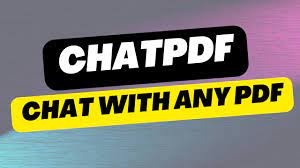In today’s fast-paced world, the ability to quickly and efficiently access and share information is more important than ever before. Many businesses and individuals rely on PDF documents to share and store important information. However, one common frustration with PDFs is the inability to easily interact with their content.
Fortunately, there are now tools available that allow for easy interaction with PDFs through chat interfaces. These tools are designed to streamline the process of sharing and collaborating on PDFs, making it easy to have conversations about the content of these documents in real time.
One of the most popular tools for chatting with PDFs is called Kami. Kami is a cloud-based platform that allows users to open, edit, and annotate PDF documents directly in their web browser. With Kami, users can highlight text, add comments, draw shapes, and more, all in real time. Additionally, Kami includes a chat feature that allows users to have conversations about the content of the document without leaving the platform.
Another popular tool for chatting with PDFs is DocHub. Like Kami, DocHub is a cloud-based platform that allows users to edit and annotate PDF documents directly in their web browser. DocHub also includes a chat feature, which allows users to have conversations about the content of the document in real time. Additionally, DocHub includes a range of collaboration tools, such as the ability to assign tasks and track changes, which can be useful for team projects.
In addition to these dedicated PDF editing tools, many chat platforms now include built-in support for PDFs. For example, Slack, one of the most popular team communication platforms, allows users to share PDFs and have conversations about them directly in the app. Similarly, Microsoft Teams includes support for PDFs, allowing users to view and annotate these documents within the app.
PDF back and forth between team members, with each person adding their own comments, a chat interface allows for real-time collaboration, streamlining the process and reducing the likelihood of errors or misunderstandings. Chatting about a PDF also makes it easier to keep all conversations about that specific document in one place, rather than scattered across multiple emails or chat messages.
Another benefit of chatting with PDFs is that it can improve efficiency. By being able to edit and annotate PDFs in real time, users can make changes quickly and easily, without having to spend time sending updated versions back and forth. This can be particularly useful in situations where time is of the essence, such as when working on a deadline or dealing with urgent information.
Chatting with PDFs can also make it easier to keep track of changes and feedback. With a chat interface, users can see the conversation history related to the PDF, making it easier to track who said what and when. This can be particularly useful for teams working on complex projects, where multiple people may be providing feedback on different aspects of a document.
Of course, there are some limitations to chatting with PDFs. For example, not all PDF editing tools include a chat feature, and not all chat platforms support PDFs. Additionally, some people may prefer to work with PDFs offline, using desktop applications such as Adobe Acrobat. However, for those who prefer to work in the cloud or who need to collaborate with others in real time, chatting with PDFs can be an extremely useful tool.
In conclusion, the ability to chat with PDFs is a relatively new but increasingly popular feature that can make collaboration and communication much easier. With the right tools, users can edit, annotate, and discuss PDFs in real time, streamlining the process and improving efficiency.

